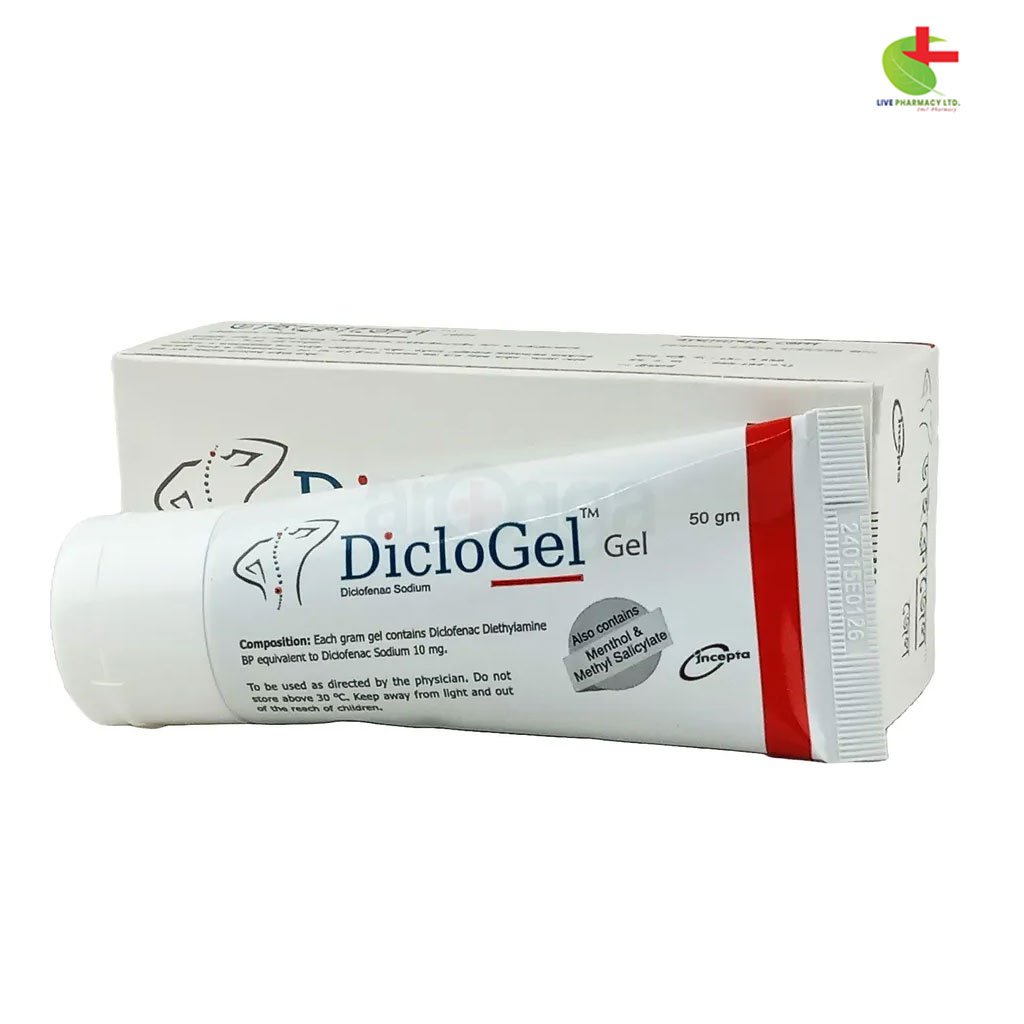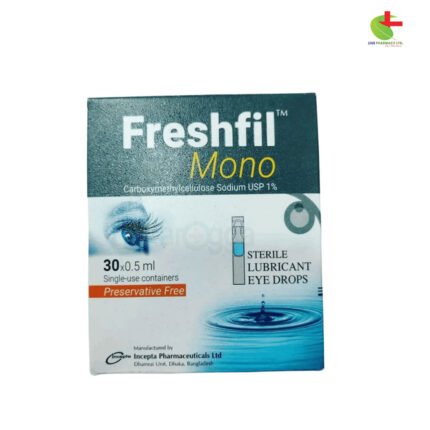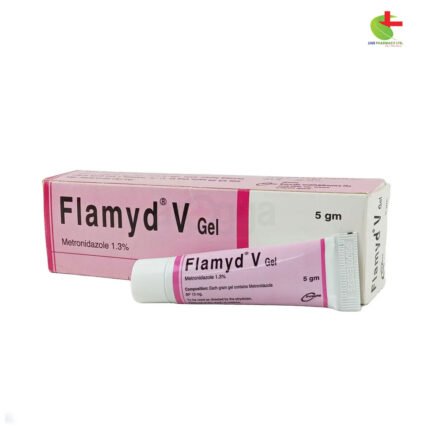DicloGel
97.00৳ Tube (50gm)
- Diclofenac Sodium is a powerful non-steroidal anti-inflammatory drug (NSAID) effective for treating various inflammatory and pain-related conditions.
- It is indicated for rheumatic disorders, post-operative pain, and acute injuries, providing relief from inflammation and discomfort.
- Available in multiple formulations, including tablets, gel, and injections, it offers versatile dosing options for adults and children.
- Consult a registered physician for appropriate usage and dosage based on individual needs.
 Brand
Brand
|
Incepta Pharmaceuticals Ltd |
|---|---|
 Generics
Generics
|
Diclofenac Sodium |
 Type
Type
|
Gel |
Indications
Rheumatology: Effective in managing both inflammatory and degenerative rheumatic conditions, including chronic involutive disorders, polyarthritis, ankylosing spondylitis, osteoarthritis, spondylarthroses, acute gout, and peri-articular rheumatic ailments.
Surgery and Traumatology: Utilized for the treatment of sprains, bruises, dislocations, fractures, soft tissue injuries, and during surgical procedures.
Obstetrics and Gynecology: Indicated for primary dysmenorrhea, episiotomy, adnexitis, endometritis, parametritis, salpingitis, and mastitis.
Otorhinolaryngology: Administered as pre-operative medication to mitigate pain, inflammation, and swelling.
Dentistry: Used for alleviating post-operative and post-traumatic pain, as well as inflammation and swelling.
Additional Indications: Employed to prevent and treat pain, inflammation, and swelling in patients undergoing procedures in the urogenital tract, as well as for renal and biliary colic relief.
Please consult a registered physician before using this medication.
Pharmacology
Diclofenac Sodium is a highly effective non-steroidal anti-inflammatory drug (NSAID) known for its strong anti-rheumatic, anti-inflammatory, analgesic, and antipyretic properties, with additional uricosuric effects. It functions primarily by inhibiting prostaglandin biosynthesis, which is critical in the development of inflammation, pain, and fever. When taken with or after meals, diclofenac is rapidly absorbed from the gastrointestinal tract, with peak plasma concentrations occurring approximately 2 hours post-ingestion. At therapeutic levels, it exhibits 99.7% binding to plasma proteins and is metabolized in the liver, undergoing first-pass metabolism.
Dosage & Administration
Diclofenac FC Tablet:
- Adults: 75-150 mg daily, divided into 2 to 3 doses, preferably after meals. Long-term use may require a dose reduction.
Diclofenac SR Tablet:
- Adults: 1 tablet daily, taken whole with liquid during meals. If needed, the dose can be increased to 150 mg by adding conventional tablets.
- Children: 1-3 mg/kg body weight daily in divided doses.
- Elderly Patients: Recommend the lowest effective dose, though pharmacokinetics remain unaffected in elderly patients.
Diclofenac Dispersible Tablet:
- Adults: Recommended daily dosage is 2-3 tablets, with a maximum of 150 mg. In milder cases, 2 tablets may suffice, ideally taken before meals.
- Children: Not generally recommended, except for juvenile rheumatoid arthritis (1-3 mg/kg body weight). Tablets should be dissolved in a half-glass of water and stirred before swallowing. Not recommended for use beyond 3 months.
Diclofenac TR Capsule: One capsule daily, preferably after meals.
Diclofenac Suppository:
- Adults: 50 mg suppository 2-3 times daily, with a maximum daily dose of 150 mg.
Diclofenac Injection: Typically, 1 ampoule daily for adults, with the possibility of increasing to 2 ampoules in severe cases.
Diclofenac Gel: For external application only. Apply 2-4 g of gel to the affected area 3-4 times daily, rubbing it lightly into the skin. This gel can be used alongside other diclofenac formulations.
Please consult a registered physician before using this medication.
Interactions
DicloGel may interact with the following medications:
- Lithium and Digoxin: May elevate plasma concentrations.
- Anticoagulants: Risk of hemorrhage may increase with concurrent use, although clinical studies show no significant effect on anticoagulant activity.
- Antidiabetic Agents: Safe for use alongside oral antidiabetic drugs without affecting their efficacy.
- Cyclosporin: Risk of nephrotoxicity when used concurrently.
- Methotrexate: Serious toxicity can occur when NSAIDs and methotrexate are taken within 24 hours of each other.
- Quinolone Antimicrobials: Risk of convulsions due to interaction with NSAIDs, warranting caution in concurrent therapy.
- Other NSAIDs and Steroids: Co-administration may increase adverse effects. Aspirin may reduce the plasma levels of both medications, although clinical significance is unclear.
Contraindications
Diclofenac is contraindicated in individuals with hypersensitivity to any of its components, those with peptic ulcers, and in asthmatic patients where exposure to acetylsalicylic acid or other prostaglandin synthetase inhibitors may trigger asthma, urticaria, or acute rhinitis. The gel should not be applied under occlusive dressings.
Side Effects
DicloGel is typically well-tolerated, with mild and transient side effects. Initial treatment may cause epigastric pain, nausea, diarrhea, dizziness, or headaches. Rarely, peripheral edema and skin reactions such as rashes or eczema may occur. Local irritation, redness, and rashes are possible with the gel.
Pregnancy & Lactation
Diclofenac should be used during pregnancy only when absolutely necessary, with the lowest effective dose recommended. Use is discouraged in the first trimester. Insufficient data suggests Diclofenac Sodium Gel should be avoided during pregnancy. Minimal amounts may be found in breast milk, with no expected adverse effects on nursing infants.
Precautions & Warnings
In rare instances, peptic ulceration or gastrointestinal bleeding may occur in patients treated with DicloGel. Close observation is advised for elderly patients. Avoid contact with eyes or mucous membranes; hands should be washed thoroughly after application. This medication should not be ingested.
Therapeutic Class
- Osteoarthritis Management
- Rheumatoid Arthritis Treatment
- Non-steroidal Anti-inflammatory Drugs (NSAIDs)
Storage Conditions
Store in a cool, dry place, away from light, and below 30°C. Keep out of reach of children.













Reviews
There are no reviews yet.